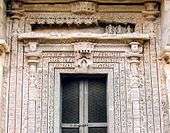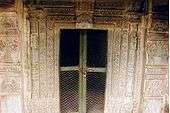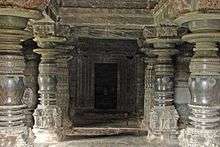Kasivisvesvara Temple, Lakkundi


The Kasivisvesvara temple (Kannada: ಕಾಶಿವಿಶ್ವೇಶ್ವರ ದೇವಸ್ಥಾನ ) (also spelt Kashivishveshvara) and sometimes called Kashivishvanatha (Kannada: ಕಾಶಿವಿಶ್ವನಾಥ ದೇವಸ್ಥಾನ ) temple is located in Lakkundi, in the (Gadag district) of Karnataka state, India. It is 11 km from Gadag city, 24 km from Dambal and about 50 km from Kuknur.[1]
The centre of cultural and temple-building activity of the Western Chalukya Empire lay in the Tungabhadra river region, where large medieval workshops built numerous monuments.[2] These monuments, regional variants of pre-existing dravida (South Indian) temples, defined the Karnata dravida tradition.[3] Lakkundi in particular was the location of the mature phase of the Western Chalukya architecture,[4] and the Kasivisvesvara temple marks a high point of these achievements. According to Henry Cousens, it is one of the most ornate temples in the Kannada spoken region of India.[5]
The existence of a 1087 CE inscription on a beam in the temple mantapa (hall) and the plainness of that part of the temple suggests that the original construction may have been simpler and that the profusion of decoration may have been added to the other parts of the temple at a later period, with the end of Chola invasions of Chalukyan territory.[5] Most of the inscriptions in Lakkundi date from 1170 CE onwards. It is known that Hoysala king Veera Ballala II annexed Lakkundi (also known as Lokkigundi) from the Seunas of Devagiri and made it his capital around 1193 CE. It is possible that the temple may have received embellishment during his rule.[6]
Temple plan

This is a double shrined temple (dvikuta). The shrine facing east is dedicated to Kasivisvesvara (Hindu god Shiva) whose universal symbol, a linga, stands three feet tall in the sanctum. The other shrine, which faces the main shrine is dedicated to the sun god Surya and is called Suryanarayana. The Surya shrine faces west, an unusual occurrence among Surya temples, which normally face east.[7] The Kasivisvesvara temple epitomises the shift in Chalukyan artistic achievements, towards sharper and crisper stone work not seen in earlier constructions, taking full advantage of the effect of light and shade. Special attention was paid to mouldings, arches and other details on the tower, and decorations on doorjambs and lintels.[6]

The architects in the Karnataka region seem to have been inspired by architectural developments in northern India. This is evidenced by the fact that they incorporated decorative miniature towers (multi-aedicular towers depicting superstructures) of the Sekhari and Bhumija types, supported on pilasters, almost simultaneously with these developments in the temples in northern India. The miniature towers represented shrines, which in turn represented deities. Sculptural depictions of deities were generally discreet although not uncommon. Other northern ideas they incorporated were the pillar bodies that appeared as wall projections.[8] Well-known constructions incorporating these features are found at the Kasivisvesvara Temple and the nearby Nannesvara Temple.[9]
Decorative features

According to Cousens, the doorpost mouldings on the southern and eastern doorway are worthy of mention. On both sides of the southern doorway are four inner bands of scrolls which run up the sides and around the lower part of the entablature above. Next to these bands, on either side, in the centre, are tall columns or pilasters supporting the lower cornice above. Beyond these columns, on either side, are four more bands of decorative mouldings.[6] On the lintel of the doorway is a dedicatory block containing an image of Gaja-Lakshmi with an elephant on either side. In fact, in the Kannada spoken regions, it is common to find the image of Lakshmi in the dedicatory block on the lintel irrespective of the temple's original dedication; whether the principal deity was Shiva, Vishnu or Jaina.[10] Above the lower cornice, the entablature consists of small figures, now numbering only three (must have been eleven originally) standing under cusped arches. Above these figures is a valance of beads hanging in festoons.[10] According to art historian Cousens, the decoration on the eastern doorway, though not a fine as on the southern doorway, is worthy of praise for its filigree work. The doorway to the shrine (sanctum) rivals the exterior ones in finish. The dedicatory block on the lintel has an image of Gaja-Lakshmi and her elephants. Above the cornice is a procession of men and animals. These images, which are barely six inches tall, include horsemen and musicians. Above these images are the trinity of Hindu gods: Brahma, Vishnu and Shiva.[11]
The ornamentation on the outer wall of the shrine consists of prominent central niches above which is a miniature tower (shikhara or aedicule) which is purely nagara (north Indian) in style and cuts through the principal cornice. The decorative arch above the miniature tower is a conspicuous ornamental feature of the superstructure. The miniature tower–arch combination is repeated up the superstructure of the shrine.[10] The finial (kalasha) and the capping structure of the tower is missing. In the temple hall, the pillars, their capital, and brackets figures above the capital (which include little lions, kirtimukhas and scrolls) are evidence of expert workmanship, the kind found on ivory or silver. The artisans fully availed the workable properties of finely grained stone (soapstone) to produce polished pillars whose shafts have a rounded appearance obtained by using a lathe.[11]
Notes
- ↑ Kamiya, Takeo (1996-09-20). "Architecture of the Indian Subcontinent". Gerard da Cunha-Architecture Autonomous, Bardez, Goa, India. Retrieved 2007-10-27.
- ↑ Hardy (1995), p 156
- ↑ Hardy (1995), pp 6–7
- ↑ Hardy (1995), p 158
- 1 2 Cousens (1926), p. 79
- 1 2 3 Cousens (1926), p. 80
- ↑ Cousens (1926), p. 81–82
- ↑ Foekema (2003), pp. 51–52
- ↑ Foekema (2003), p51, p53
- 1 2 3 Cousens (1926), p. 22
- 1 2 Cousens (1926), p. 81
References
| Wikimedia Commons has media related to Kasivisvesvara Temple, Lakkundi. |
- Cousens, Henry (1996) [1926]. The Chalukyan Architecture of Kanarese Districts. New Delhi: Archaeological Survey of India. OCLC 37526233.
- Hardy, Adam (1995) [1995]. Indian Temple Architecture: Form and Transformation-The Karnata Dravida Tradition 7th to 13th Centuries. Abhinav Publications. ISBN 81-7017-312-4.
- Foekema, Gerard (2003) [2003]. Architecture decorated with architecture: Later medieval temples of Karnataka, 1000–1300 AD. New Delhi: Munshiram Manoharlal Publishers Pvt. Ltd. ISBN 81-215-1089-9.
- Kamiya, Takeyo. "Architecture of Indian subcontinent". Indian Architecture. Gerard da Cunha. Retrieved 2008-08-16.
Coordinates: 15°23′22″N 75°42′51″E / 15.38944°N 75.71417°E